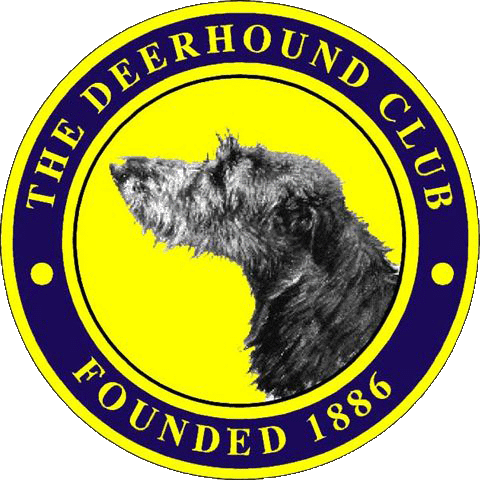History of the Deerhound |
|
HistoryThere are some excellent books about Deerhounds of the past, written by those who had first-hand knowledge of their breeding and of their working ability against their original quarry. It is intended, therefore, to give only a brief outline, which it is helpful to keep in mind when reading the standard. As early as the third century, dogs of the greyhound type were known and used for hunting. In the fifteenth century, references to and the pictures of the English Greyhound, Highland Deerhound and Irish Wolfhound show that these breeds were developing along similar lines and had a marked resemblance to each other. There are various references to the ancestors of the breed as Scotch Greyhounds, Rough Greyhounds, Scottish Deerhounds, Irish Greyhounds and Highland Deerhounds, and it is not clear when they first became known as Deerhounds. Before the middle of the eighteenth century, there was considerable diversity in appearance, but by then there were two distinct strains, the Highland and the Lowland. The former was taller, stronger and with a heavier coat than the latter. Originally they were used to course the deer from start to finish. On sighting the quarry, two hounds were slipped to course the deer and either kill it or bring it to bay until the hunters arrived. Later, with the improvement in firearms, they were usually required to track or follow a wounded animal and bring it to bay. One of the most precarious times in the breed’s history seems to have been at the beginning of the nineteenth century, when many of the large Scottish estates were split into small estates for sporting purposes, and few then kept Deerhounds for hunting deer. The new fashion was for stalking and shooting, which required only a tracking dog to follow the line of a wounded animal, and for which purpose a collie or similar breed was found to be more suitable, being more biddable and with better scenting abilities. Although a few estates still employed Deerhounds for their original work, on most estates they became obsolete and the breed was left in the hands of a few enthusiasts. Vitality was low and various outcrosses were used to improve size and vigour. One of the most famous ‘Deerhounds’. Sir Walter Scott’s Maida, was actually sired by a Pyrenean out of a Deerhound Bitch. He had a lot of white in his coat, but improved size and substance in his offspring. Bloodhounds were sometimes used to improve scenting ability for tracking wounded game and Borzoi to improve quality and grace of movement. The oldest known strain is possibly the Chesthill, established by Menzies at the beginning of the nineteenth century. Others are Morrison of Glenelg, M’neil of Colonsay and Bateson of Cambusmere. The last provided the inspiration for much of the Landseer’s work as he considered them the finest examples he has seen. Towards the end of the nineteenth century, Captain Graham compiled a book of pedigrees of the most notable dogs with measurements and comments on each. It is interesting to note that the average height for a bitch was then twenty-six inches and for a dog twenty-nine inches, (often with a girth of three or four inches more than this), and a height of twenty-nine inches was considered the most suitable size for deer coursing. Although weight and strength were needed, it was felt that a dog much taller than this could be too large and awkward for the job. Agility and stamina were also necessary and, perhaps most important, the keenness and tenacity to pursue the quarry. The Deerhound Club was formed in 1886 and, when the breed standard was first drawn up in 1892, the height of dogs was twenty-eight to thirty inches, or ‘even more if there is to be symmetry without coarseness which, however, is rare’ and the height given for bitches was twenty-six inches upwards, with ‘no objection being made to a bitch being large unless coarse, as even at her greatest height she does not approach that of the dog, and therefore could not be too big for work, as over-big dogs are’. In 1907, among the qualities aimed for were a height of less than thirty inches and weight not greater than 105 pounds, with too great a heaviness of bone to be avoided. In 1948 the Standard was amended to the present height requirements. In the nineteenth century, the advent of dog shows brought change, and sometimes exaggeration, to many breeds but helped to stabilise the Deerhound and give enthusiasts a purpose to aim for now that the original work was scarce. It gave owners the chance to compare and compete and follow common objectives, which are sometimes lost along with a breed’s natural purpose. Many of the enthusiasts then had been lucky enough to see the breed in its original work and would therefore have this in mind when breeding. These days, few owners have ever witnessed this but, nevertheless, it should always be kept in mind, whether you wish to show, or breed, or course other quarry, or simply enjoy the companionship of this wonderful breed. For more in-depth reading about the history of the breed, readers could look out for copies of ‘Scottish Deerhounds and their Masters’ by George Cupples, or ‘The Scottish Deerhound’ by Weston Bell, which has recently been reprinted. Reproduced by kind permission of Kay Barret from her book "Living with Deerhounds". |
